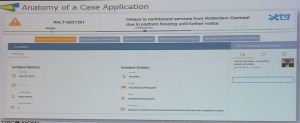Case management at TIBCONOW 2016
Blog: Column 2 - Sandy Kemsley
Breakout sessions continue with Jeremy Smith and Nicolas Marzin of TIBCO presenting their case management functionality. Marzin went through the history of process and how we have moved from pre-defined processes and automation to more flexible and personalized work methods; in general, this is driving the application of case management and other unstructured work tools in addition to structured BPM. It’s no longer just about cost-cutting and efficiency, but also about innovation, agility and competitive differentiation. Although he made a link between case management and digital disruption, there are also many use cases for more flexible work handling, such as claims management and incident handling.
Smith talked about the case-centric capabilities enabled by ActiveMatrix BPM, presenting it as an approach to building applications rather than a separate product offering. He made the distinction between back office processes, where the organization determines the employees’ journey (I don’t fully agree, since there is a lot of back office knowledge work), while the path of front office processes are driven by the customer. TIBCO takes a data-centric approach to case management, where any entity can be a case, and a case can contain processes (or process fragments), rules, actions, analytics, and collaboration. Unlike the usual big process application built with AMX BPM, case management can start much simpler with the objects, data and basic actions, then add in more of the capabilities as the needs emerge.
 He showed a transportation-related case dashboard used by a knowledge worker, with a milestone/stage timeline, business actions (which may trigger processes), case details, and contextual details (linked cases, processes, tasks and navigation). States and actions drive the cases forward rather than pre-defined processes, so that actions can be triggered when certain states are reached or data values updated. Workers can select actions based on the case state and their permission level.
He showed a transportation-related case dashboard used by a knowledge worker, with a milestone/stage timeline, business actions (which may trigger processes), case details, and contextual details (linked cases, processes, tasks and navigation). States and actions drive the cases forward rather than pre-defined processes, so that actions can be triggered when certain states are reached or data values updated. Workers can select actions based on the case state and their permission level.
This seems to be more of an application framework/example than a case management platform, although the claim is that semi-technical analysts can create these applications. There’s another session later today on the low-code application development environment used to create case management applications; there are certainly a lot of questions left unanswered by this session about how case really fits in with AMX BPM.
Leave a Comment
You must be logged in to post a comment.







